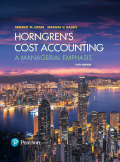
Concept explainers
Material-cost variances, use of variances for performance evaluation. Katharine Johnson is the owner of Best Bikes, a company that produces high-quality cross-country bicycles. Best Bikes participates in a supply chain that consists of suppliers, manufacturers, distributors, and elite bicycle shops. For several years Best Bikes has purchased titanium from suppliers in the supply chain. Best Bikes uses titanium for the bicycle frames because it is stronger and lighter than other metals and therefore increases the quality of the bicycle. Earlier this year, Best Bikes hired Michael Bentfield, a recent graduate from State University, as purchasing manager. Michael believed that he could reduce costs if he purchased titanium from an online marketplace at a lower price.
Best Bikes established the following standards based upon the company’s experience with previous suppliers. The standards are as follows:
| Cost of titanium | $18 per pound |
| Titanium used per bicycle | 8 lbs. |
Actual results for the first month using the online supplier of titanium are as follows:
| Bicycles produced | 400 |
| Titanium purchased | 5,200 lb. for $88,400 |
| Titanium used in production | 4,700 lb. |
- 1. Compute the direct materials price and efficiency variances.
Required
- 2. What factors can explain the variances identified in requirement 1? Could any other variances be affected?
- 3. Was switching suppliers a good idea for Best Bikes? Explain why or why not.
- 4. Should Michael Bentfield’s performance evaluation be based solely on price variances? Should the production manager’s evaluation be based solely on efficiency variances? Why is it important for Katharine Johnson to understand the causes of a variance before she evaluates performance?
- 5. Other than performance evaluation what reasons are there for calculating variances?
- 6. What future problems could result from Best Bikes’ decision to buy a lower quality of titanium from the online marketplace?
Want to see the full answer?
Check out a sample textbook solution
Chapter 7 Solutions
EBK HORNGREN'S COST ACCOUNTING
- Need correct answer general Accountingarrow_forwardYear 0123 Cash Flow -$ 19,000 11,300 10,200 6,700 a. What is the profitability index for the set of cash flows if the relevant discount rate is 11 percent? Note: Do not round intermediate calculations and round your answer to 3 decimal places, e.g., 32.161. b. What is the profitability index for the set of cash flows if the relevant discount rate is 16 percent? Note: Do not round intermediate calculations and round your answer to 3 decimal places, e.g., 32.161. c. What is the profitability index for the set of cash flows if the relevant discount rate is 23 percent? Note: Do not round intermediate calculations and round your answer to 3 decimal places, e.g., 32.161. a. Profitability index b. Profitability index c. Profitability indexarrow_forwardSol This question answerarrow_forward
- Recently, Abercrombie & Fitch has been implementing a turnaround strategy since its sales had been falling for the past few years (11% decrease in 2014, 8% in 2015, and just 3% in 2016.) One part of Abercrombie's new strategy has been to abandon its logo-adorned merchandise, replacing it with a subtler look. Abercrombie wrote down $20.6 million of inventory, including logo-adorned merchandise, during the year ending January 30, 2016. Some of this inventory dated back to late 2013. The write-down was net of the amount it would be able to recover selling the inventory at a discount. The write-down is significant; Abercrombie's reported net income after this write-down was $35.6 million. Interestingly, Abercrombie excluded the inventory write-down from its non-GAAP income measures presented to investors; GAAP earnings were also included in the same report. Question: What is the impact on Abercrombie & Fitch's financial statements from the write-down of its logo-adorned merchandise…arrow_forwardTherefore the final answerarrow_forwardAns ? General Accounting questionarrow_forward
- Principles of Accounting Volume 2AccountingISBN:9781947172609Author:OpenStaxPublisher:OpenStax College
